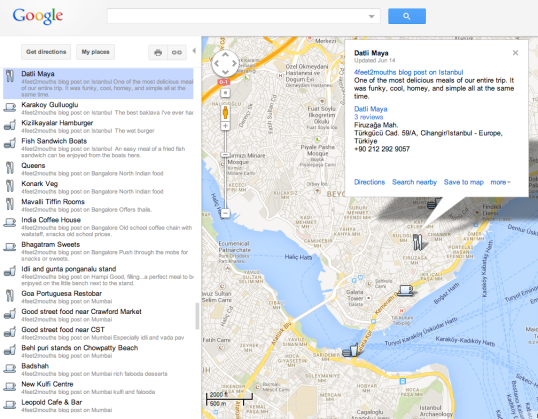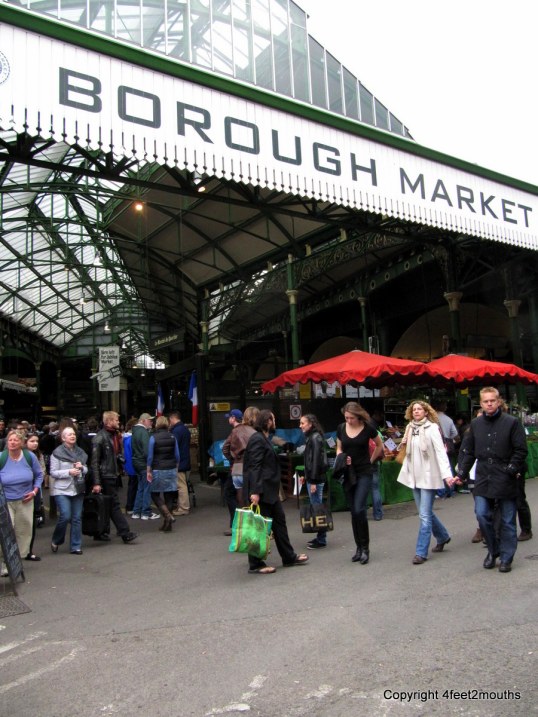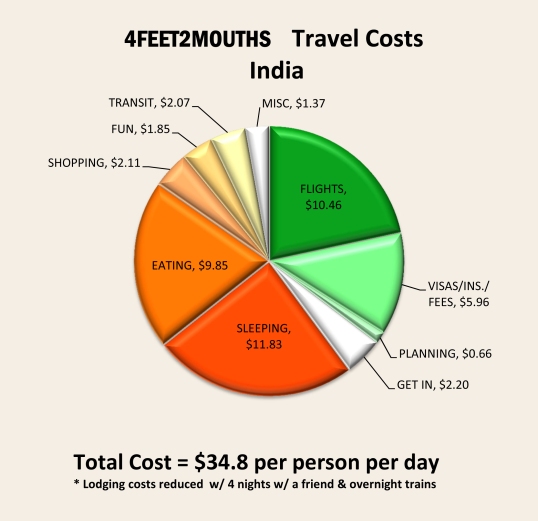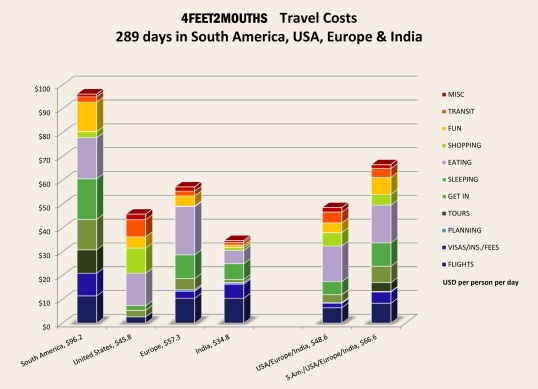
Northside of Uçhisar castle in Cappadocia
Life without travel, to us, is not life. In February of 2012 we set out on an adventure beyond what anyone could fathom. Our destinations would be magnificent and our itinerary complex. We gave up most of our possessions and set out to explore the world. I remember our last night in Berkeley, we sat on the floor of our empty apartment eating a fabulous cheeseboard pizza washed down with rosé (from a winery aptly named L’aventure, The Adventure). Both of us were nervous about what might happen over the next year. We wanted needed to travel. There is only so much ground that can be covered on two week vacations, so we postponed our careers in search of historical, cultural and culinary education. We met wonderful people and saw countless jaw-dropping sights. In total we explored over 100 villages, towns and big cities in eighteen countries on four continents through 410 days of travel. It was a wild ride of buses, rickshaws, trains and walking on our own two feet. The best part is that I would not change any bit of it. Every experience has its place and memory that I love.

Last meal in our Berkeley apartment: Cheeseboard pizza & L’Aventure Rose (perfect)
I think the most impressive achievement of traveling is the accumulation of memories. Every day traveling creates a new experience, a beautiful sight, a peculiar food or an awkward cultural exchange. Each one of these unique events is stored within my brain like a painting of a vibrant and textured year. The events shine with such color and flavor that Carmen and I can quiz each other and remember what we ate, saw and did exactly on any day of the last year. What were you doing last May 7, 2012? We woke up at sunrise and walked across the Isla del Sol on Lake Titicaca in Bolivia, then bused to Puno, Peru and had Chinese food while watching a Bruce Lee soap opera with a funny theme song chorus. I look back at my years working and there are a few standout events, work milestones, or an exceptionally fun weekend or a fabulous meal we created with friends. But for the most part, memories just are not stored vividly because they get lost in the routine of the day to day while traveling provides so many novel experiences.

Nathan taking a rest during a hike

Carmen and another day of travel
The memories of our trip hit me with amazing detail. We are constantly asked what our favorite part of the trip was. It is virtually impossible to compile millions of wonderful memories and synthesize them in a single answer. We hiked mountains, canyons and through forests and ate dosas, ceviche and hot pot. And we loved every bit of all of it. I have tried to go through some of our favorite activities, tastes and sights and tried to compile a brief list of some of the “bests” of fourteen months of travel.

Rio de Janiero – Ipanema Sunrise

Best Big Cities: London, Hong Kong, Istanbul, Chengdu

Carmen and I love big cities. We love the life that one can feel in a city. The people thrive with high-rises, public transit, beautiful museums, beaches and sights. The food tingles with flavors so intense that the tongue and entire body becomes addicted. And although there may be culture-shock these cities are welcoming and encouraging to be a tourist and maybe an inhabitant. I loved Rio de Janiero from our week traveling there in March 2012. The city is beautiful and the music passionate. I can’t wait to go back. London and Hong Kong are of course one of our most favorite cities in the world. Chengdu feels a bit more scattered in its design, but remains one of my favorites for the food alone. Istanbul is a gem in the world, a perfect crossing point for Asia and Europe with all the delicacies and beauty that make it uniquely Turkish.

Shaxi, our favorite small town
The small towns often get missed in lists like these. We visited a perfect little village named Shaxi in between Dali and Lijiang. It was quaint and picturesque, and a wonderful variation from the Chinese tourist cities that are so common. Unfortunately it is changing and I expect that it will not be the same when I return. We visited countless small towns during our Camino de Santiago trek, each dainty or dusty, but fun to explore in search of a café cortado.

Tartine bread pudding with strawberries

Best Sweets: baklava, sweet soup. Mango sticky rice & alfajores

Amazingly enough we did discover coffee during our travels abroad. Both Carmen and I appreciated coffee, but refused to be addicted so we drank it very rarely. Walking across Spain changed that, now we just have to limit intake. There are few better things to have a coffee with than bread pudding. Tartine in San Francisco makes my absolute favorite dessert of the year. We always used to eat here, but after having it again with strawberries, I cannot help but put it at the top of the list. Other favorites include Honeymoon Desserts’ sweet soup and alfajores. Mango sticky rice is so simple and perfect that I wish I could eat it every day. In Turkey we tried to eat baklava every day, which were all phenomenal. One place, Karaköy Güllüoğlu, created nut and phillo pillows of gold. The fact is that there are just too many excellent places to eat while traveling.

Gong Bao Ji (Chicken)

Best Foods: ceviche, rajas y queso, boat noodles & pho

I still stand my original statement on Chengdu that the gong bao chicken we ate on Renmin Zhonglu remains one of my favorite meals. I am so happy that we ate there twice! Another favorite is La Super Rica; you can order blindly here and you will be very happy. Boat noodles and pho are charactieristic of the flavors of Thailand and Vietnam. In general, the everyday food in South America is rather mediocre. Culinary enthusiasts should rightly stay in Asia. Although we loved the pizzas of Buenos Aires, my real favorite of South America was the ceviche that we consumed in large amounts in Lima Peru. Survival during travel is not on food alone, it is the sights that often distinguish the destinations.

Ephesus library

Best Ruins: Machu Picchu, Angkor Wat, Caryatids on the Acropolis, Vittana Temple & carved church in Cappadocia

In school I never really liked history. It seemed like such a mish-mash of random wars and crap that never mattered. Then I started traveling and developed a love of understanding cultures and people and the history leading to their current lives. I find that I can spend all day bouncing around a set of ruins, crawling around a cave or reading countless interpretive signs. Seeing a place brings the history to life and ingrains a sense of reality that these events actually happened. Some of my favorite places were the Inca Trail, Angkor and Athens; there are so many ruins that can be enjoyed and each building, wall and path defines a little bit of history that is easier to understand. India’s civilization is thousands of years old and the variety of ruins and temples demonstrates a wealth of history. One of our favorite cities was Hampi, the ruins were spread out, but beautiful and easy to explore. Cappadocia was honestly unbelievable: underground cities and fairy chimney houses really do exist.

Hagia Sofia, most impressive building
We were doubly awestruck when visiting the Hagia Sofia. It is old enough to be in ruins, built 500ad, but still remarkably towers above and beyond what many modern engineers are designing. I was deeply moved and inspired by this magnificent building and I look forward to seeing it and Istanbul again. Beyond the buildings and the history it was the landscapes that intrigued us and kept us walking and walking and walking.

Grand Canyon Sunset from Cape Final

Best Landscapes: Salkantay, Camino de Santiago, Salar de Uyuni & Cappadocia

The landscapes of the world vary drastically. The contrasts between mountains, canyons and forests are immense, but one thing is for certain: the human heart is sure to skip a beat at certain places on this planet. We sought out many of these spectacular sights, and some of my favorites include: camping beneath Salkantay mountain on the Inca Trail, The deserts, rocks and salt flats leading up to the Salar de Uyuni and Cappadocia rock formations and hot air balloons. Grand Canyon, despite its ubiquity as being a beautiful destination, remains one of my favorite places. We trekked for eight days and loved all the nuances, textures and colors that transition throughout the day. We experienced so many beautiful things: Tiger Leaping Gorge and Zhangjiajie come to mind in China or Cafayate and Iguazu in Argentina; each is its own special and vibrant memory.

Walking the Camino de Santiago towards Sahagún
I value each experience of our trip uniquely, but one was critical to my well-being and my development as a human- walking the Camino de Santiago. The steadiness of walking, the meditation involved with each step and the time to think is phenomenal. I finished the Camino confident that I could achieve anything, but humbled that I finished it with someone I love, Carmen. Walking the Camino de Santiago is special and life-changing for everyone in their own way. I feel that I could walk it again tomorrow and it would still bring value and pleasure to my travels.

Nathan & Carmen at Condoritos Park
We often get concerns about our travels. People care to know about muggings, stolen property and the life and death situations that might have caused us head home. Carmen and I were very fortunate to not have any serious turmoil happen to us while traveling. Our worst evening was spent shivering on the side of the road next to the Condoritos Park. We did hear of some friends who had cameras stolen from buses in Tupiza, or friends of friends who were pick-pocketed in Rio, but none of these things happened to us. We did accidentally leave a nice steel canteen in Sao Paulo and another Nalgene on a minibus in Zhongdian, but that is it. Carmen and I are very meticulous to carry very little, we pack light and we walk with our hands free and we secure our money when we get it. We were lucky, but I feel that the people of the world are generally nice and helpful. People in Vietnam were extremely welcoming and kind to us throughout our trip and we experienced zero hard feelings for being American. In fact, everyone was welcoming; we, for the most part, only encountered nice and thoughtful people. (That crazy girl in Tiger Leaping Gorge kung fu kicks into my memory.) Our trip was a great success and I feel confident that we could travel anywhere and have similar experiences and treatment.

Nathan getting a mud cleanse
Just as fast as the date came for us to embark, it was time to settle down. We traveled hard and fast. We were diligent to explore as many parts of the world as we could. Language and food was no barrier, and we were entertained by the beautiful sights that both nature and humans have created. The challenge with any travel is that the world never feels smaller. The world feels more accessible, but our bucket lits of places to go and things to see has only grown larger than when we left. The question we have to figure out now, is what country we will travel to next?

Carmen sandbar silhouette in Ilha do Mel
Many of you have been our readers throughout this journey and I thank you for your support. For those who have just started following us: there is a wealth of excellent photos and information in our past posts. Future posts will continue to entertain on the travel and food theme that we all love.












































































































































































































